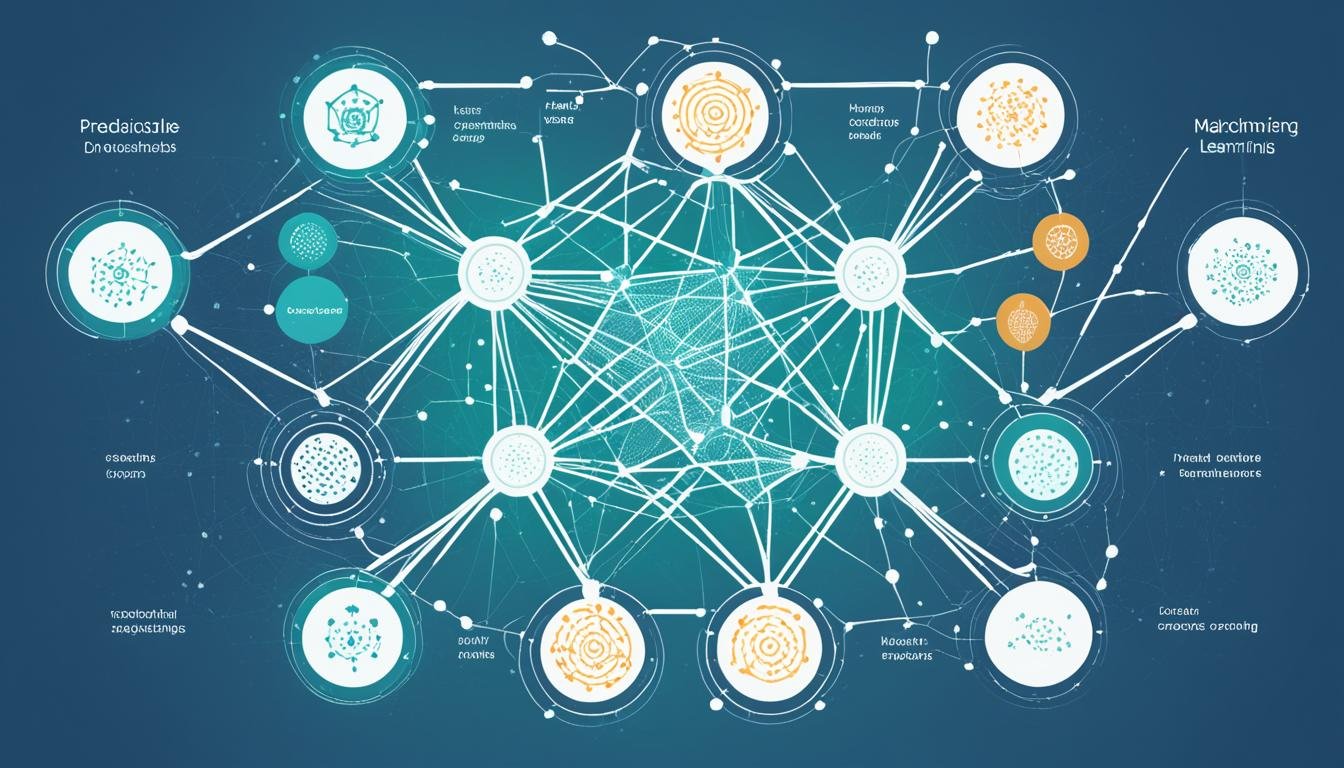From Algorithms to Predictions: How Machine Learning Makes Decisions
Have you ever wondered how machines make choices like humans do? The answer lies in machine learning. It’s an important part of artificial intelligence. Machine learning uses special algorithms to understand and predict outcomes. These algorithms become smarter over time as they see more data.
Thus, machine learning turns into a powerful tool for making smart decisions based on data. It can understand complicated systems and predict the future better than we can. In fields like healthcare and retail, machine learning is changing how we solve problems. It offers new insights and more efficiency, making a big impact.
Key Takeaways
- Machine learning was named by American computer scientist Arthur Samuel in 1959. It’s the basis for many AI applications.
- There are different types of machine learning algorithms, like supervised, semi-supervised, unsupervised, and reinforcement learning.
- Some well-known machine learning algorithms are Decision Trees, Artificial Neural Networks, and Random Forests.
- Machine learning gets better with new data, improving its decision-making accuracy.
- Transportation, healthcare, and retail are just a few of the industries benefiting from machine learning.
Introduction to Machine Learning
In the 1950s, Arthur Samuel put the term “machine learning” into play. This key idea lets computers do things on their own, using data to act without direct instructions. At first, it was only for spotting simple patterns. But now, machine learning does much more.
Definition and Scope
Machine learning is all about algorithms that learn and decide on their own from data. AI has quickly advanced to cover many types of learning. This includes making predictions from labeled data and finding hidden insights in data with no labels. It’s changing how we do things in finance, healthcare, and beyond.
Historical Context
Machine learning began with Arthur Samuel teaching a computer to play checkers in 1959. Since then, it has grown a lot. We now have tools like Support Vector Machines and techniques such as classification and regression. These help with tasks like figuring out feelings from text.
Importance in Modern AI
Machine learning is key in today’s AI progress. Big names like Google and Microsoft use it heavily. They solve hard problems like recognizing images and understanding language with deep learning. So, machine learning shapes our future tech in many ways.
Types of Machine Learning Algorithms
Machine learning covers many tools to solve data problems. These include supervised, unsupervised, semi-supervised, and reinforcement learning. Each type has its way to process data, making machine learning versatile.
Supervised Learning
Supervised learning needs data with labels to teach models. It’s used for tasks like sorting or making predictions. Algorithms like the Naïve Bayes Classifier, Support Vector Machine (SVM), and regression models are widely used for different types of predictions.
Unsupervised Learning
Unsupervised learning finds hidden patterns in data without category tags. It’s great for grouping info together with the help of the K Means Clustering Algorithm. This method is key for understanding data relationships and structures.
Semi-Supervised Learning
Semi-supervised learning uses some labeled data and a lot of unlabeled info. It’s a blend of supervised and unsupervised methods, often helpful when there’s not much labeled data. This approach can make models stronger and more effective when working with big amounts of data.
Reinforcement Learning
Reinforcement learning teaches algorithms by letting them make and learn from mistakes. They work towards rewards, getting better at tasks over time. This method is ideal for tasks that change or evolve, demanding adaptive solutions.
How Machine Learning Algorithms Work
Machine learning algorithms follow a systematic three-step process. This ensures they make accurate predictions and fit the model well. They are based on decision processes, error functions, and model optimization procedures.
Decision Process
Every machine learning algorithm begins with a decision process. It deals with predicting or classifying input data. This is key for high accuracy, as it finds patterns and makes smart choices from the given data. Algorithms in supervised learning, like Naïve Bayes and Linear Regression, use labeled data for exact predictions.
Error Function
The error function, or loss function, is critical for checking prediction accuracy. It measures the difference between the predicted and real outcomes. Using this information, the algorithm refines itself, improving classification accuracy. Techniques in unsupervised learning, such as K Means Clustering, use this to enhance their performance.
Model Optimization Process
Model optimization is the last and continuous step for better algorithm performance. It includes tweaking parameters and weights based on error feedback to reduce errors and improve fitting. For algorithms like Artificial Neural Networks and Decision Trees, this is crucial. It helps the models adapt, offering reliable predictions and insights.
Machine learning algorithms adaptively improve their performance as the number of samples and the quality of data increase.
Understanding and refining these steps lets data scientists boost the power of machine learning. These algorithms become valuable across many fields, from marketing analytics to medical diagnostics. The aim is always to reach the highest accuracy and provide valuable predictions.
Supervised Learning Techniques Explained
Supervised learning is a major technique in the field of machine learning. It uses labeled data to train models. This method lets models connect inputs to the right outputs. It’s key for many predictive tasks. There are three main types: classification, regression, and forecasting.
Classification
This technique assigns data into classes. Models like the Naïve Bayes Classifier and Support Vector Machine are good at this. It’s important in fields like medicine, for diagnosing based on symptoms. It’s also used in finance, for credit scoring.
Regression
Regression looks at the connections between different variables. It uses methods like Linear Regression and Logistic Regression. These help in fields like sensing and trading. Linear predicts continuous outcomes, while Logistic is for yes or no outcomes.
Forecasting
Forecasting predicts future trends using past data. Models like Decision Trees and Artificial Neural Networks are used. They help in understanding market changes, energy use, and sales. They are key parts of data strategies today.
To sum up, supervised learning includes classification, regression, and forecasting. It helps make smart predictions. These methods are getting more popular in many areas, helping them grow and work better.
Unsupervised Learning Techniques Explored
Unsupervised learning is vital in machine learning. It doesn’t need labeled data sets. It’s used to pick out patterns in unlabeled data. For example, it can help with customer segmentation and image recognition.
Clustering
Clustering groups data points based on similarities. K-means clustering algorithm is a common approach. It places data into K groups depending on how close they are to that group’s center. Other methods, such as hierarchical clustering, use different ways to connect data, for example, using Euclidean distance.
Dimension Reduction
Has too much data? Dimension reduction can help. It simplifies big data sets by using fewer variables. This keeps important data but makes it easier to understand. Principal Component Analysis (PCA), Singular Value Decomposition (SVD), and Autoencoders are good at this. They point out the most valuable data, saving time and making work more efficient.
Popular Machine Learning Algorithms
Machine learning introduces us to powerful algorithms for data analysis and prediction. The Naive Bayes, K-Means, SVM, and neural networks are among the top choices. They are critical in handling various machine learning tasks.
Naive Bayes Classifier
The Naive Bayes algorithm is a tool based on Bayes’ theorem. It assumes features are independent, which helps tackle complex issues well. Despite being simple, it is quick and scalable, suitable for big data analyses.
K-Means Clustering
The K-Means method is a key unsupervised learning technique. It groups data into K clusters, placing each point with the closest cluster mean. This process is great for identifying data patterns and structures automatically.
Support Vector Machines
SVM is highly efficient for tasks in many dimensions. This algorithm aims to draw the best line for separating classes. It is crucial for demanding tasks like image and text sorting.
Artificial Neural Networks
Neural networks mimic the brain’s architecture, perfect for handling non-linear relationships. Comprising interconnected layers, they process data in stages. They’re crucial in various areas, from recognizing voices to self-driving cars.
Benefits of Machine Learning in Decision Making
Machine learning changes how we make decisions. It brings speed, accuracy, and new ideas to the table. These tools are key for any business facing tough competition.
Speed and Scalability
Machine learning can process huge amounts of data quickly. This scalable algorithms help find detailed patterns fast. This speed gives organizations a big advantage, allowing them to make strategic decisions in real-time.
Accuracy and Reliability
When machine learning is right, it boosts prediction accuracy and cuts down errors. This is because it consistently provides dependable data. The key here is that the model keeps getting better with time. Yet, we must watch out for overfitting, a common challenge.
Adaptability and Innovation
Machine learning is all about adapting and coming up with new ways to solve problems. Its flexibility allows it to improve continuously. By focusing on data quality and clear explanations (Explainable AI), the models’ fairness gets a big check. It’s important to keep an eye on these models to avoid potential biases.
Challenges of Machine Learning for Decision Making
Machine learning is making big changes in many fields. It helps by offering new, clever fixes. But, there are big hurdles that can slow it down. We need to look at challenges like getting good data, making models easy to understand, and making sure decisions are fair for everyone.
Data Quality and Availability
Machine learning’s results are as good as the data it uses. Quality and the amount of data matter a lot. Good data is key for getting predictions right and making good decisions. But, if we lack data, or the data is wrong or unfair, the results will be off. For example, a healthcare study showed how using high-quality data makes machine learning work well in that field.
Interpretability of Models
Model interpretability is another big issue. It’s important to know how a model makes its choices. This is especially true in areas like health and finance, where we must be able to explain the model’s decisions. Although complex models can predict well, they often seem like a mystery. They are hard to understand because they are like “black boxes.” Making models easier to understand is known as improving ML interpretability. This helps everyone trust the model’s choices.
Biases and Fairness Issues
Models can sometimes keep unfair ideas that were in their data. This causes big fairness problems. It can lead to wrong choices in hiring, loans, and law. Making machine learning fairness means checking data for unfairness and fixing it. We need to keep an eye on the models to make fair choices over time.
Solving these problems is crucial for using machine learning the right way. As we go on, fixing how we use data in ML, ML interpretability, and making machine learning fair is very important. It will help us make good choices in all kinds of jobs.
From Algorithms to Predictions: How Machine Learning Makes Decisions
Machine learning changes raw info into helpful forecasts using a complex and dynamic process. This is known as ML predictive analysis. By studying the input, these programs guess the output within a correct range. This makes algorithmic decision-making quick and spot-on.
“The choice of the best machine learning algorithm depends mostly on the data’s size, quality, and what you want to find out.”
Supervised learning methods like Naive Bayes Classifier and Support Vector Machines use tagged info to do tasks very accurately. Tasks include placing items in certain groups or figuring out future numbers. For example, Linear Regression examines how different objects relate. Meanwhile, Logistic Regression figures out the chance of certain events happening.
Unsupervised learning uncovers patterns in data without human tags, using methods like K-Means. There are also ways to simplify info, which helps find clearer truths. Reinforcement learning learns by trying, improving guesswork as it goes.
Applications like AI-supported marketing or spotting fraud in real-time banking show how useful machine learning is in algorithmic decision making. It automates tasks and gets better with time, becoming essential in many fields.
Conclusion
Machine learning is key in bringing us advanced technology today. It makes our decisions smarter with its predictive power. This shows how much we rely on data-driven ideas in many fields worldwide.
Different types of machine learning exist. They include supervised, unsupervised, semi-supervised, and reinforcement learning. Each type helps us understand big sets of data. For example, neural networks act like our brains, and there are simpler models like linear regression. Over time, these methods have become better at handling data accurately.
We use techniques such as clustering and decision trees to help sort, categorize, and predict. These tools are critical in our world, which is all about data. They make machine learning essential to our daily lives.
The rise of Industry 4.0 is speeding up how we use these technologies. It’s making our operations more efficient and sparking new ideas. This shift is making machine learning and AI more important for our future.
Source Links
- https://www.sas.com/en_gb/insights/articles/analytics/machine-learning-algorithms.html
- https://www.ibm.com/topics/machine-learning-algorithms
- https://www.latentview.com/blog/the-role-of-machine-learning-in-automating-decision-making-processes/
- https://monkeylearn.com/machine-learning/
- https://www.xponance.com/an-introduction-to-machine-learning/
- https://builtin.com/data-science/tour-top-10-algorithms-machine-learning-newbies
- https://www.mathworks.com/discovery/machine-learning.html
- https://www.leewayhertz.com/supervised-machine-learning/
- https://www.ibm.com/topics/unsupervised-learning
- https://forbytes.com/blog/main-machine-learning-techniques/
- https://www.simplilearn.com/10-algorithms-machine-learning-engineers-need-to-know-article
- https://www.valuecoders.com/blog/analytics/role-of-machine-learning-in-predictive-analytics-and-decision-making/
- https://cdt.org/ai-machine-learning/
- https://www.ncbi.nlm.nih.gov/pmc/articles/PMC9337975/
- https://www.frontiersin.org/articles/10.3389/fcvm.2021.765693
- https://www.ibm.com/topics/machine-learning
- https://link.springer.com/article/10.1007/s42979-021-00592-x








